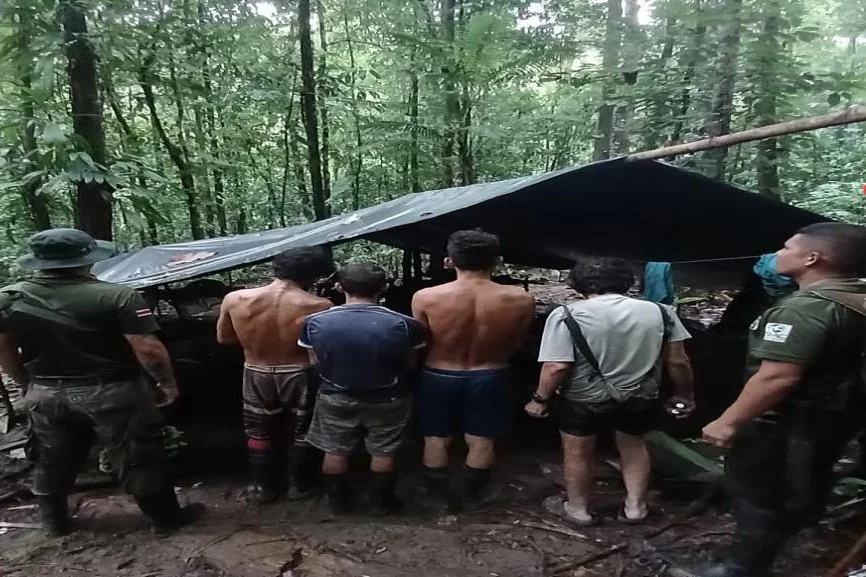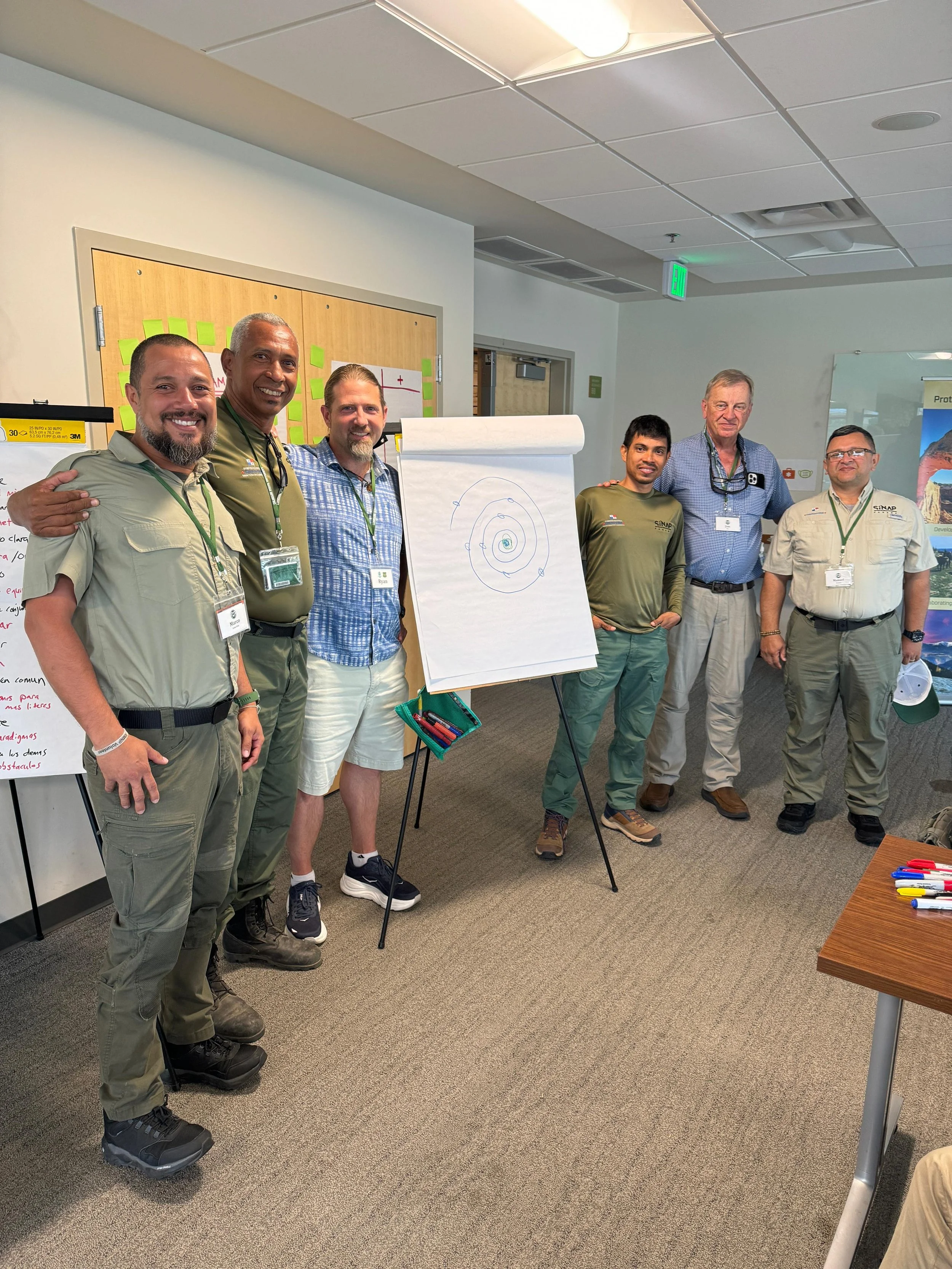Deploying Global Park Defense for Cocos Island Marine Protection
Introduction to Cocos Island, Costa Rica
Cocos Island National Park, located 550 km off the Pacific coast of Costa Rica, is the only island in the tropical eastern Pacific with a tropical rainforest. Its position as the first point of contact with the northern equatorial counter-current, and the myriad interactions between the island and the surrounding marine ecosystem, make the area an ideal laboratory for the study of biological processes. The underwater world of the national park has become famous due to the attraction it holds for divers, who rate it as one of the best places in the world to view large pelagic species such as sharks, rays, tuna and dolphins.
Since 1978, the island has been safeguarded as The Cocos Island National Park (CINP) because of its abundant fauna and biodiversity. The Bicentennial (Seamounts) Marine Management Area (BMMA) was created in January 2022 by enlarging the entire marine protected area (MPA). This action boosted the country's ocean protection from 2.7% to almost 30% and tenfold increased the MPA to 106,285.56 square kilometers.
From left to right: Scalloped Hammerhead, Silky Shark, and Galapagos Shark. Photos by shutterstock/adobestock.
“Natural population densities of large top predators indicate a near pristine conservation status of a property that is among the most important sites in the Eastern Tropical Pacific for the protection of large pelagic migratory species, such as the endangered Scalloped Hammerhead Shark and the near-threatened Silky Shark and Galapagos Shark. Due to its geographical position, the oceanic island of volcanic origin is the first landmark met by the North Equatorial Countercurrent and a point of confluence of other marine currents. This makes it a dispersing centre of larvae of marine species from various parts of the Pacific Ocean. In its land portion, the property hosts a remarkable degree of endemism across most diverse taxonomic groups. There are, for instance, three endemic bird species, two endemic freshwater fish and two endemic reptile species. Cocos Island National Park is of irreplaceable global conservation value, reminding us what parts of tropical oceans historically looked like. “
-UNESCO World Heritage Convention
Global Conservation Funds New Radar Deployment
GC is supporting WildAid's critical work to protect the Cocos Marine Conservation Area (ACMC), as well as developing and implementing a state-of-the-art Marine Protection System (MPS) to strengthen ACMC's monitoring, control, and surveillance (MCS) capacity. Through a sizable donation form GC, which contributed toward 50% of the cots of the radar, WildAid was able to complete the necessary resources for the acquisition of the radar for Cocos Island and the auxiliary outboard diesel engine for the Cocos Patrol.
As part of this work, WildAid held peer-to-peer exchange and training in Galapagos National Marine Park in Ecuador with their Costa Rican counterparts, including five National Park officials and representatives from the Costa Rican Coast Guard INCOPESCA, the national fishing authority.
Participants gained insights into the collaborative management of control and surveillance efforts deployed in the Galapagos for safeguarding natural resources and enforcing laws, as well as the operational dynamics of the Galapagos Control and Surveillance Center, including its equipment and procedures, with the intention of replicating these practices within the ACMC.
Participants also engaged in boat patrols to gain firsthand knowledge of control and surveillance protocols during navigation, as well as the systems used. They also visited the Ecuadorian Navy's monitoring center facilities to combat illegal fishing.
Why A New Radar
A tropical storm severely damaged the Kelvin Hughes radar, prompting the acquisition and installation of a new radar system for Cocos Island. According to recommendations from the National Coast Guard Directorate and the Anthropocene Institute, the acquired radar had to meet the following requirements: Transportation and installation are to be executed collaboratively with the Costa Rica Coast Guard.
A Vessel Monitoring Control Center was also established, providing satellite monitoring to access VMS data via the THEMIS Web monitoring platform and enabling real-time monitoring of Costa Rica's advanced longline fleet, bolstering surveillance along the Pacific marine corridor.
Officials from ACMC and SINAC's Marine Unit received training on the use of satellite monitoring platforms, with a specific focus on Themis and Global Fishing Watch. The Satellite Monitoring Center integrates electronic monitoring surveillance into daily operations, enhances personnel capacity to implement a modern law enforcement program, and increases vessel availability for patrolling the waters.
Although scalloped hammerheads appear to be social creatures for at least a portion of the year, scientists are unaware of the reasons behind their sporadic huge group formations after prolonged periods of solitary behavior. Photo by Shutterstock.
The WildAid Marine Program Reports Back to GC
Since 2022, WildAid has been collaborating with the Cocos Marine Conservation Area (ACMC) to develop and implement a Marine Protection System (MPS).
Marine Protection System Plan for Cocos
The Marine Protection System Plan for Cocos The PNIC Marine Protection System (PNIC-MPS) was finalized in November 2022. In March 2023, WildAid held an inter-institutional meeting to prepare the PNIC-MPS Annual Operating Plan for the calendar year 2023. Based on this plan, WildAid has been providing ongoing technical support to facilitate system implementation and strengthen ACMC’s monitoring, control, and surveillance (MCS) capacity.
Galapagos Peer-to-Peer Exchange with Costa Rican Counterparts
An inaugural activity on the agenda was the organization of a peer-to-peer exchange between officials from the Galapagos National Park and Cocos Marine Conservation Area (PNIC/AMMB). This exchange, spanning from April 24th to 28th in Galapagos, brought together five ACMC officials, one representative from the Directorate General of the Coast Guard, and one INCOPESCA official.
The primary objectives were threefold:
To gain insights into the collaborative management of control and surveillance efforts deployed in the GNPS for safeguarding natural resources and enforcing laws.
Secondly, to understand the operational dynamics of the Galapagos Control and Surveillance Center, including its equipment and procedures, with the intention of replicating these practices within the ACMC.
Lastly, participants engaged in Makaira boat patrols to acquire firsthand knowledge of control and surveillance protocols during navigation, as well as the systems employed in the GNPS.
Throughout the exchange, key activities included visiting the DIRNEA monitoring center facilities of the Ecuadorian Navy to combat illegal fishing, receiving presentations on the progress and challenges of the SPM ACMC and the Galapagos Marine Reserve's SPM, exploring the workings of the Control Center and its technology, and participating in sessions on control and monitoring procedures during Makaira boat navigation.
Costa Rican Coastguard Informational Exchange with ACMC
The subsequent exchange activity aimed to acquaint ACMC personnel with the operations and workflow of the Coast Guard Monitoring Center while fostering collaboration between the two institutions on control and surveillance matters. Nine ACMC officials attended this visit to the Control Center of the Coast Guard General Directorate on Thursday, June 29. The visit provided an opportunity for a comprehensive understanding of the center's functioning, facilitating the implementation of similar practices in the ACMC's Monitoring and Control Center. We also prioritized enhancing infrastructure, technology, and equipment to strengthen control and surveillance activities in Cocos.
Have you seen our new Marine Protection Handbook?
Authored by Dr. Lida Teneva, a world-renown ocean conservationist, the GC Marine Protection Handbook provides sage wisdom, case studies combined with common sense, and step by step objectives towards achieving real MPA Protection.






















